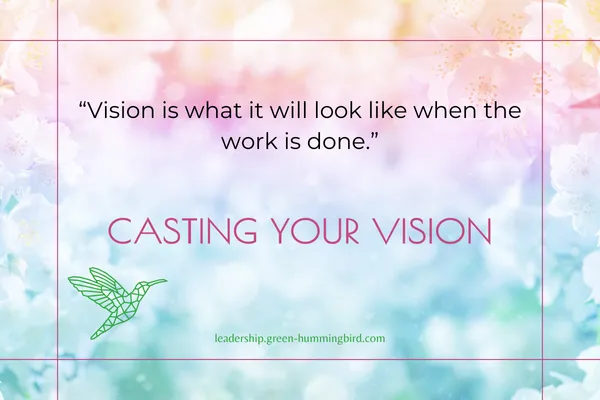
Casting Your Vision
Casting Your Vision
Theme: Vision
Vision means a lot of different things to a lot of different people, in different contexts. A leader is expected to cast a vision for the organization, as well as their team. But, as with Values, it should also overlap with the Vision the leader has for their own life.
The Vision is what it should look like when the work is done.
Every organization, company, and business should have some kind of broad vision for how their presence in the world makes the world different. It’s not a concrete map of how they will go about changing the world, but it’s more like an idea of what they want the world to look like because they are in it. That organizational Vision is what informs the direction the Mission should take it.
But as a leader, when you are responsible for staying on course to accomplish that Vision, you need to:
Hope- Communicate the feeling of hope that this Vision will accomplish.
Plan- Have a general idea for how the Vision can be accomplished. It gives you a direction to go to make it more than a dream.
Strategize- Think up ways that you can accomplish that plan.
Who can help?
Where should it be located for greatest impact?
What might it cost?
Be Financially Conscious- many Visionaries don’t consider this. You can have all the dreams in the world, but if you don’t have the money to accomplish them (in our current Capitalist society), you could end up doing more harm than good. Consider:
How much money will it need?
How many employees?
How much do they need to be paid?
Benefits?
Taxes?
Location costs?
Material costs?
Marketing?
Insurance?
Licenses/Dues/etc?
Travel Expenses?
Continuing education?
Hiring outside professionals (lawyers, accountants, etc)
Slush fund for unexpected expenses
Where will the money come from?
Sales?
Investors?
Donations?
Grants?
Evaluate- Once you’ve been working on this Vision for a certain amount of time, ask if you are closer to the Vision than you were before all that work.
What has been accomplished?
What improvements need to be made?
What surprises were encountered?
Many use a SWOT analysis to get this process started
Having a Vision is more than just having a dream. It’s the first step to taking action to fulfill that dream. The dream of what the organization can accomplish, the leader’s dream of what the team can accomplish, and your dream for what you can accomplish.
Examples
Pretend you bought an old house with the intention of modernizing it.
Vision: a modern house with the charm of an older house.
Mission: to fix anything broken, and update technology to be more functional in the modern era.
You can come up with various quests within that
updating the kitchen
updating the master bedroom
installing A/C
Within each quest, you may have multiple goals.
kitchen update may need:
new counters
new cabinets
new cooking range
new floors
Each goal may have multiple projects, which will have multiple tasks you must complete.
The Vision is what it will look like when the work is done.
As another example, if you are a choreographer:
Vision: how the entire show will look once officially performed onstage.
Mission: to hold the performance(s) to show the Vision.
Quest: to get all the performers onboard.
Goals: to get all the performers…
to be where they need to be,
doing what they need to do,
at the appropriate time for each of them.
Projects: the performers themselves.
Tasks: The movements, placement, and timing of each individual performer.

In my last job, the Vision statement of the organization was, “We work toward a transformed City where all people find hope and a future.” Short, simple, but not exactly a road map. It’s not supposed to be! We worked toward that Vision by providing services to children and families within the community. There are a lot of ways we could have done work to fulfill the Vision statement. But pushing through decisions about health and safety that made staff feel unsafe to be doing their jobs definitely was not a way to work toward a transformed City where ALL people find hope and a FUTURE. That is what my former boss did that started the downward spiral to my leaving. The organization is a shadow of its former self now, because it’s being run by someone who has lost sight of the Vision.
Key Insights
It’s like this for the organization, your team, and your personal life. The organization should have a vision statement already, about how the world will be different because of the organization… Simon Sinek calls this your “Why” in “Start with Why”. Why are we bothering to do this at all? It’s the classic, “What is my motivation?” line that’s attributed to actors.
You can do this for your personal life, as well. It’s why you work at all: because your Vision of your future includes things that cost money that you wouldn’t otherwise have, or because you truly want to affect the world, or both! But if you’re reading this, I’m assuming your Vision for your future is not to live on the street with no food or money.
As a leader, you should have a Vision for your team, too. This is something most managers don’t consider. As a leader, you lead people. What do you want for those people to accomplish within that organization?
Remember to cast a Vision for:
The organization
The team
Yourself
What This Means for Neurodivergent Leaders
For many of us, depending on our type of Neurospicy, it can be easy to get wrapped up in the day-to-day details of what we’re working on, and easy to forget the big picture. This is common with Autistic leaders.
Or it can be really easy to dream up a creative Vision, but difficult to see it through before we’re inspired to dream up something new. This is common with ADHDers.
As an AuDHDer, I’ve done both. I can hyperfocus on the details of one thing while dreaming up a new thing and never finish either.
But I think what is most important with Vision work is to be able to communicate it clearly, and use it as a lens through which to think through our personal and leadership choices.
And I think that once we engrain a truth within ourselves, we have a harder time ignoring it than neurotypicals do.
Tips & Action Steps
There are a few things people like to do to brainstorm and follow through on their Visions. Depending on your type of Neurosparkly and just general preferences, one or more of these might work for you.
Meditation can help you clear your mind and open you to inspiration.
Vision Boards can help with inspiration:
Can be pictures, drawings, words, quotes.
Can be physical or Digital
Can be for a project, a period of time, for organization or team, or for your life
Can include dreams and goals for:
Work
Relationships
Family
Home
Finances
Purchases
The point is to have it where you can see it to regularly remind you of the Vision
Journaling can help clarify the Vision.
Writing a letter to your future self can promote commitment to the Vision.
For my part, I like to start by drawing out my whole Vision. But I'm not much of an artist, and I tend to be more literal minded, so I draw something more like a Bubble Map or a flow chart or something. It ends up being a slightly more organized Brain Dump that I later wordsmith.
Ultimately, we all have to find what creative outlet works best for us in order for us to dream, implement, and follow through on our Vision, for our organization’s impact on the world, for our teams, and for ourselves.


